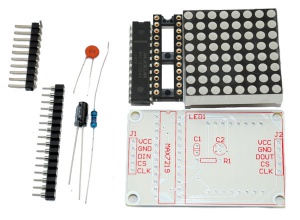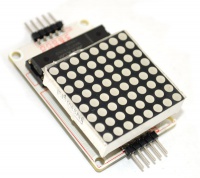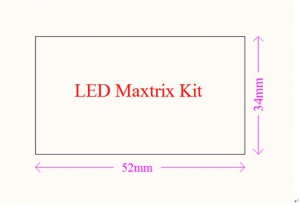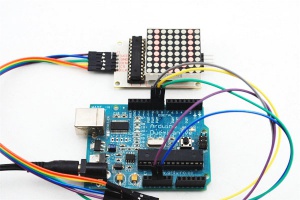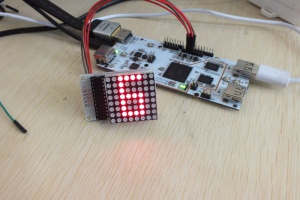MAX7219 SDK
Single Matrix Display
输入端:input end, 级联输出端: output end
Introduction
This product is a serially driven 8x8 LED Matrix kit powered by MAX7219.
It only needs three data lines and two power lines.
The 8x8 LED Matrix is easy to use and compatible with Arduino, and its LED brightness adjustment can be implemented in software.
8x8 LED Matrix kit has many applications in real life, such as various types of electronic display panels. If the LED matrix is not driven by any peripherals, it’ll waste the interface of devices, and the LED brightness will be impaired due to insufficient power, so that we cannot get ideal display effect.
The LED matrix can be driven in two ways: parallel or serial. We usually drive it in the serial manner in order to save interface. The serial-driven LED matrix actually dynamically displays the LEDs, i.e., displays the LEDs row-by-row or column-by-column. The persistence of vision for humans is about 0.1s, so as long as we can serially display all 8 rows/columns within 0.1s, we’ll see a complete character or pattern.
This product comes in the form of a kit. It includes the following components:
- MAX7219
- Electrolytic cpaacitor:10uF/25V
- Resistor:10K
- Capacitance:0.1uF
- Headers and receptacles.
After assembling, it will look as:
Specification of LED Matrix
DIMENSIONS
- Operating Voltage: DC 4.7V – 5.3V
- Typical Voltage: 5V
- Operating Current: 320mA
- Max Operating Current: 2A
- Operating Temperature: 0 ℃ – 50 ℃
- Typical Temperature: 25 ℃
Wiring
1.Wiring Instructions
- Connect Arduino pin8 to DIN on 8x8 LED Matrix
- Connect Arduino pin9 to CS of 8x8 LED Matrix
- Connect Arduino pin10 to CLK of 8x8 LED Matrix
- Connect Arduino 5V to VCC of 8x8 LED Matrix
- Connect Arduino GND to GND of 8x8 LED Matrix
Attention:8*8LED Matrix must be common-grounded with Arduino module.
2.Check the corresponding interfaces are properly connected.
3.Powering up the Arduino demo board with AC adapter.
4.Observation:The LED matrix should circularly display the digits 0 to 9 on LED screen first, then the characters A to Z, as shown in the above figure.
- Open Arduino development environment.
- Copy the source code we provide into Arduino compiler, and compile them.
- Select proper serial port and board.
- 4.Connect pins according to the schematics, and download codes into Arduino board. You’ll see the LED matrix circularly display the digits 0-9 and the characters A-Z.
Demo Code
#include "core.h"
unsigned char i;
unsigned char j;
int Max7219_pinCLK = 8;
int Max7219_pinCS = 9;
int Max7219_pinDIN = 10;
unsigned char disp1[38][8] =
{
{0x3C,0x42,0x42,0x42,0x42,0x42,0x42,0x3C},//0
{0x10,0x30,0x50,0x10,0x10,0x10,0x10,0x10},//1
{0x7E,0x2,0x2,0x7E,0x40,0x40,0x40,0x7E},//2
{0x3E,0x2,0x2,0x3E,0x2,0x2,0x3E,0x0},//3
{0x8,0x18,0x28,0x48,0xFE,0x8,0x8,0x8},//4
{0x3C,0x20,0x20,0x3C,0x4,0x4,0x3C,0x0},//5
{0x3C,0x20,0x20,0x3C,0x24,0x24,0x3C,0x0},//6
{0x3E,0x22,0x4,0x8,0x8,0x8,0x8,0x8},//7
{0x0,0x3E,0x22,0x22,0x3E,0x22,0x22,0x3E},//8
{0x3E,0x22,0x22,0x3E,0x2,0x2,0x2,0x3E},//9
{0x8,0x14,0x22,0x3E,0x22,0x22,0x22,0x22},//A
{0x3C,0x22,0x22,0x3E,0x22,0x22,0x3C,0x0},//B
{0x3C,0x40,0x40,0x40,0x40,0x40,0x3C,0x0},//C
{0x7C,0x42,0x42,0x42,0x42,0x42,0x7C,0x0},//D
{0x7C,0x40,0x40,0x7C,0x40,0x40,0x40,0x7C},//E
{0x7C,0x40,0x40,0x7C,0x40,0x40,0x40,0x40},//F
{0x3C,0x40,0x40,0x40,0x40,0x44,0x44,0x3C},//G
{0x44,0x44,0x44,0x7C,0x44,0x44,0x44,0x44},//H
{0x7C,0x10,0x10,0x10,0x10,0x10,0x10,0x7C},//I
{0x3C,0x8,0x8,0x8,0x8,0x8,0x48,0x30},//J
{0x0,0x24,0x28,0x30,0x20,0x30,0x28,0x24},//K
{0x40,0x40,0x40,0x40,0x40,0x40,0x40,0x7C},//L
{0x81,0xC3,0xA5,0x99,0x81,0x81,0x81,0x81},//M
{0x0,0x42,0x62,0x52,0x4A,0x46,0x42,0x0},//N
{0x3C,0x42,0x42,0x42,0x42,0x42,0x42,0x3C},//O
{0x3C,0x22,0x22,0x22,0x3C,0x20,0x20,0x20},//P
{0x1C,0x22,0x22,0x22,0x22,0x26,0x22,0x1D},//Q
{0x3C,0x22,0x22,0x22,0x3C,0x24,0x22,0x21},//R
{0x0,0x1E,0x20,0x20,0x3E,0x2,0x2,0x3C},//S
{0x0,0x3E,0x8,0x8,0x8,0x8,0x8,0x8},//T
{0x42,0x42,0x42,0x42,0x42,0x42,0x22,0x1C},//U
{0x42,0x42,0x42,0x42,0x42,0x42,0x24,0x18},//V
{0x0,0x49,0x49,0x49,0x49,0x2A,0x1C,0x0},//W
{0x0,0x41,0x22,0x14,0x8,0x14,0x22,0x41},//X
{0x41,0x22,0x14,0x8,0x8,0x8,0x8,0x8},//Y
{0x0,0x7F,0x2,0x4,0x8,0x10,0x20,0x7F},//Z
{0x8,0x7F,0x49,0x49,0x7F,0x8,0x8,0x8},// {0xFE,0xBA,0x92,0xBA,0x92,0x9A,0xBA,0xFE},
};
void Write_Max7219_byte(unsigned char DATA)
{
unsigned char i;
digitalWrite(Max7219_pinCS,LOW);
for(i=8;i>=1;i--)
{
digitalWrite(Max7219_pinCLK,LOW);
if((DATA&0x80)==0x80) digitalWrite(Max7219_pinDIN,HIGH);
else digitalWrite(Max7219_pinDIN,LOW);
DATA = DATA<<1;
digitalWrite(Max7219_pinCLK,HIGH);
}
}
void Write_Max7219(unsigned char address,unsigned char dat)
{
digitalWrite(Max7219_pinCS,LOW);
Write_Max7219_byte(address);
Write_Max7219_byte(dat);
digitalWrite(Max7219_pinCS,HIGH);
}
void Init_MAX7219(void)
{
Write_Max7219(0x09, 0x00);
Write_Max7219(0x0a, 0x03);
Write_Max7219(0x0b, 0x07);
Write_Max7219(0x0c, 0x01);
Write_Max7219(0x0f, 0x00);
}
void setup()
{
pinMode(11,OUTPUT);
pinMode(12,OUTPUT);
digitalWrite(11,LOW);
digitalWrite(12,HIGH);
pinMode(Max7219_pinCLK,OUTPUT);
pinMode(Max7219_pinCS,OUTPUT);
pinMode(Max7219_pinDIN,OUTPUT);
delay(50);
Init_MAX7219();
}
void loop()
{
for(j=0;j<38;j++)
{
for(i=1;i<9;i++)
Write_Max7219(i,disp1[j][i-1]);
delay(500);
}
}
